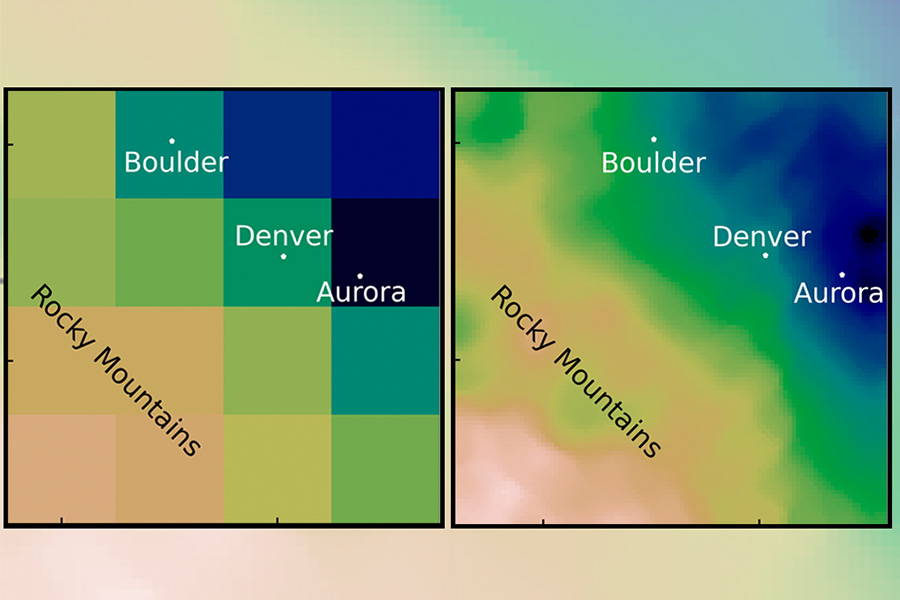
Climate models are a key technology in predicting the impacts of climate change. By running simulations of Earth’s climate, scientists and policymakers can estimate conditions such as rising sea levels, flooding, and rising temperatures and decide how to respond appropriately. However, current climate models struggle to provide this information quickly enough or at an affordable cost to be useful at smaller scales such as the size of a city.
Now the authors of a new open access paper published in Journal of Advances in Modeling Earth Systems found a method to use machine learning to take advantage of current climate models while reducing the computational cost required to run them.
“It turns conventional wisdom on its head,” says Sai Ravela, a principal scientist in MIT’s Department of Earth, Atmospheric and Planetary Sciences (EAPS), who co-authored the paper with EAPS postdoc Anamitra Saha.
Traditional wisdom
In climate modeling, downscaling is the process of using a coarse-resolution global climate model to generate finer detail over smaller areas. Imagine a digital image: A global model is a large image of the world with a low pixel count. To reduce the size, zoom in on just the part of the photo you want to look at—for example, Boston. But because the original image was low resolution, the new version is blurry; doesn’t provide enough detail to be particularly useful.
“If you go from coarse to fine resolution, you have to add information somehow,” explains Saha. Downscaling will try to add this information back by filling in the missing pixels. “This addition of information can happen in two ways: It can either come from theory or it can come from data.”
Conventional downscaling often involves using physics-based models (such as the process of air ascent, cooling and condensation, or the topography of an area) and supplementing it with statistical data taken from historical observations. However, this method is computationally intensive: It takes a lot of time and computing power to run, and it is also expensive.
A bit of both
In their new paper, Saha and Ravela came up with a way to add data in a different way. In machine learning, they used a technique called adversarial learning. It uses two machines: One generates the data for our photo. But the second machine evaluates the sample by comparing it to the actual data. If it thinks the image is fake, the first machine has to try again until it convinces the second machine. The ultimate goal of the process is to create high resolution data.
The use of machine learning techniques such as adversary learning is not a new idea in climate modeling; where it currently struggles is an inability to master a great deal of basic physics such as conservation laws. The researchers found that simplifying the physics involved and supplementing it with statistics from historical data was enough to produce the desired results.
“If you augment machine learning with some information from statistics and simplified physics, then all of a sudden it’s magical,” says Ravela. He and Saha began estimating extreme rainfall amounts by removing the more complex physical equations and focusing on water vapor and the topography of the land. They then generated general precipitation patterns for both mountainous Denver and flat Chicago, using historical accounts to correct the output. “It gives us extremes, just like physics, at a much lower cost. And it gives us a similar speed to statistics, but at a much higher resolution.”
Another unexpected benefit of the results was how little training data was needed. “The fact that it only took a little bit of physics and a little bit of statistics to improve the performance of an ML (machine learning) model wasn’t really obvious from the beginning,” says Saha. Training takes only a few hours and results can be achieved in minutes, an improvement over the months other models take.
Quickly quantify the risk
The ability to run models quickly and frequently is a key requirement for stakeholders such as insurance companies and local policy makers. Ravela gives the example of Bangladesh: When we look at how extreme weather events will affect a country, decisions about what crops should be grown or where populations should move can be made taking into account a very wide range of conditions and uncertainties as early as possible.
“We can’t wait months or years to be able to quantify that risk,” he says. “You have to look into the future and a lot of uncertainty to say what might be a good decision.”
While the current model only deals with extreme precipitation, the next step for the project is to train it to examine other critical events such as tropical storms, winds and temperatures. With a more robust model, Ravela hopes to use it in other locations, such as Boston and Puerto Rico, as part of the Climate Grand Challenges project.
“We’re very excited about both the methodology we’ve put together and the potential applications it could lead to,” he says.
